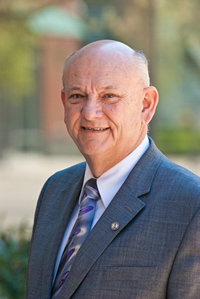About NUCPS
A Message from the Executive Director
 With thousands of former students engaged in law enforcement and traffic safety professions around the globe, NUCPS has earned the reputation as the worldwide leader in law enforcement professional development and education. At last count, more than 550 police chiefs, sheriffs and directors of state policing agencies currently serving in the United States are graduates of NUCPS. We conduct classes and research projects not only in North America, but also in the Middle East, Asia, Europe, South America, and Africa.
With thousands of former students engaged in law enforcement and traffic safety professions around the globe, NUCPS has earned the reputation as the worldwide leader in law enforcement professional development and education. At last count, more than 550 police chiefs, sheriffs and directors of state policing agencies currently serving in the United States are graduates of NUCPS. We conduct classes and research projects not only in North America, but also in the Middle East, Asia, Europe, South America, and Africa.
Our commitment to excellence is stronger than ever. Our values and mission statement continue to drive us to provide the highest quality training and education to those who commit their lives to preserving the peace and serving others. As a student you deserve nothing less. You will find our programs challenging and rewarding. We will bring out the best in you and provide the educational tools to enable you to maximize your knowledge, skills and abilities. I invite you to become part of an elite, one hundred thousand-strong cadre of public service professionals making a global impact on public safety.
Sincerely,
David Bradford
Executive Director
NUCPS Mission Statement
Serve
- public safety organizations and other entities
By
- setting the standard for quality education with real-world application,
- being the industry-leading resource regarding public safety issues, and
- initiating and sustaining connections among professionals; thereby
Driving
- the development of public safety professionals at all stages of their careers and contributing to the
Advancement
- of a safer society
More than 80 Years of Excellence
A Brief History of NUCPS
In 1904, due to the number of automobiles already in the community, Evanston, Illinois, established an eight-mile per hour speed limit on city streets in an effort to regulate traffic in the interest of public safety. In what one local journalist named a "speed trap," officers from the Evanston Police Department (EPD) hid in bushes and timed passing automobiles with stopwatches as they drove between two tape markers placed on the pavement. Despite these early efforts, traffic crashes became a problem, and in 1927, Evanston was ranked fifth in the nation in traffic crashes and fatalities, many of which involved pedestrians.
Recognizing the tragic impact upon families and communities resulting from such high crash rates, Franklin M. Kreml, a young Evanston police officer and a full-time undergraduate student at Northwestern, led the effort to address the issue. In 1929, EPD established the Accident Prevention Bureau under then-Sgt. Kreml's direction. The bureau developed a traffic safety model that brought together research, education, engineering, and enforcement. As a result, the National Safety Council declared Evanston as "America’s Safest City."
In 1936, Northwestern established the Traffic Safety Institute with Lt. Kreml as its founding director. The Institute also served as the operating arm of the first Traffic Safety Committee of the International Association of Chiefs of Police (IACP). The Traffic Institute quickly became a world leader in traffic crash investigation, prevention, and law enforcement management and has maintained that reputation ever since. In fact, we literally “wrote the book” on crash investigation and reconstruction, and its textbooks continue to set the standard for crash investigators around the world.
In addition to education, NUCPS helped to successfully lobby for the establishment of the Highway Safety Act of 1970 which created the National Highway Traffic Safety Administration. Today, we continue to be part of national efforts to develop highway design standards that maximize safety, to identify and evaluate strategies to combat impaired driving, and to identify and highlight model traffic service personnel and programs among the nation’s law enforcement agencies.
The world has changed significantly since our founding in 1936; however, the need for solid, cutting-edge education has not. Expanding the scope of the Traffic Institute's programs to include a comprehensive offering of crash investigation and transportation engineering, police training, and management courses, Northwestern renamed the Traffic Institute to the Northwestern University Center for Public Safety (NUCPS) in 2000. In recognition of NUCPS's dedication to public safety, City of Chicago Mayor Rahm Emanuel proclaimed Sunday, October 23, 2011, as “Northwestern University Center for Public Safety Day.”
NUCPS continues to build on the Institute's tradition of excellence through our educational programs offered in Evanston, across the US, and around the world.
Northwestern Transportation Library
In 1959, the Northwestern University Traffic Institute (now the Northwestern University Center for Public Safety) merged its library holdings with those of the Northwestern University Transportation Library, which now is home to the largest private collection of transportation, highway traffic control, highway safety, and criminal justice literature in the country. The Transportation Library's collection includes more than 155,000 books, technical reports, pamphlets, government documents, doctoral dissertations, newsletters, journals, and periodicals — and more than 85,000 documents are available on microform. The library also is a subscriber to abstracting services and electronic bibliographic retrieval services, and the library is a regional center in the national network of Transportation Research Information Services (TRISNET).
The Transportation Library's experienced librarians are available to assist NUCPS instructors and students in literature searches, bibliographic studies, and acquisition of hard-to-locate materials and documents. Their specialized knowledge of the subject matter greatly facilitates the acquisition of writings that have had a limited distribution. Such library capabilities are vital to NUCPS's programs.


